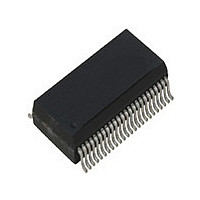ICS1893BF IDT, Integrated Device Technology Inc, ICS1893BF Datasheet - Page 34

ICS1893BF
Manufacturer Part Number
ICS1893BF
Description
PHYCEIVER LOW PWR 3.3V 48-SSOP
Manufacturer
IDT, Integrated Device Technology Inc
Series
PHYceiver™r
Type
PHY Transceiverr
Specifications of ICS1893BF
Protocol
MII
Voltage - Supply
3.14 V ~ 3.47 V
Mounting Type
Surface Mount
Package / Case
48-SSOP
Lead Free Status / RoHS Status
Contains lead / RoHS non-compliant
Number Of Drivers/receivers
-
Lead Free Status / Rohs Status
Not Compliant
Other names
1893BF
Available stocks
Company
Part Number
Manufacturer
Quantity
Price
Part Number:
ICS1893BF
Manufacturer:
ICS
Quantity:
20 000
Company:
Part Number:
ICS1893BFI
Manufacturer:
OKI
Quantity:
1 934
Part Number:
ICS1893BFILF
Manufacturer:
ICS
Quantity:
20 000
Company:
Part Number:
ICS1893BFLF
Manufacturer:
ICS
Quantity:
409
Part Number:
ICS1893BFLF
Manufacturer:
ICS
Quantity:
20 000
Part Number:
ICS1893BFLFT
Manufacturer:
IDT
Quantity:
20 000
6.2.2 Auto-Negotiation: Parallel Detection
ICS1893BF, Rev. F, 5/13/10
6. To indicate that the auto-negotiation process is complete, the ICS1893BF sets bits 1.5 and 17.4 high to
The ICS1893BF supports parallel detection. It is therefore compatible with networks that do not support the
auto-negotiation process. When enabled, the Auto-Negotiation sublayer can detect legacy 10Base-T link
partners as well as 100Base-TX link partners that do not have an auto-negotiation capability.
The Auto-Negotiation sublayer performs this parallel detection function when it does not get a response to
its FLP bursts. In these situations, the Auto-Negotiation sublayer performs the following steps:
1. It sets the LP_AutoNeg_Able bit (bit 6.0) to logic zero, thereby identifying the remote link partner as not
2. It sets the bit in the Auto-Negotiation Link Partner Abilities Register that corresponds to the 'parallel
3. It sets the Status Register’s Auto-Negotiation Complete bit (bit 1.5) to logic one, indicating completion
4. It enables the detected link technology and disables the unused technologies.
A remote link partner that does not support the auto-negotiation process does not respond to the
transmitted FLP bursts. The ICS1893BF detects this situation and responds according to the data it
receives. The ICS1893BF can receive one of five potential responses to the FLP bursts it is transmitting:
FLP bursts, 10Base-T link pulses (that is, Normal Link Pulses), scrambled 100Base IDLEs, nothing, or a
combination of signal types.
A 10Base-T link partner transmits only Normal Link Pulses when idle. When the ICS1893BF receives
Normal Link Pulses, it concludes that the remote link partner is a device that can use only 10Base-T
technology. A 100Base-TX node without an Auto-Negotiation sublayer transmits 100M scrambled IDLE
symbols in response to the FLP bursts. Upon receipt of the scrambled IDLEs, the ICS1893BF concludes
that its remote link partner is a 100Base-TX node that does not support the auto-negotiation process. For
both 10Base-T and 100Base-TX nodes without an Auto-Negotiation sublayer, the ICS1893BF clears bit 6.0
to logic zero, indicating that the link partner cannot perform the auto-negotiation process.
If the remote link partner responds to the FLP bursts with FLP bursts, then the link partner is a 100Base-TX
node that can support the auto-negotiation process. In this case, the ICS1893BF sets to logic one the
Auto-Negotiation Expansion Register’s Link Partner Auto-Negotiation Ability bit (bit 6.0).
If the Auto-Negotiation sublayer does not receive any signal when monitoring the receive channel, then the
QuickPoll Detailed Status Register’s Signal Detect bit (bit 17.3) is set to logic one, indicating that no signal
is present.
Another possibility is that the ICS1893BF senses that it is receiving multiple technology indications. In this
situation, the ICS1893BF cannot determine which technology to enable. It informs the STA of this problem
by setting to logic one the Auto-Negotiation Expansion Register’s Parallel Detection Fault bit (bit 6.4).
logic one. After successful completion of the auto-negotiation process, the ICS1893BF
Auto-Negotiation sublayer performs the following steps:
a. It sets to logic one the Status Register’s Auto-Negotiation Complete bit (bit 1.5, which is also
b. It enables the negotiated link technology (such as the 100Base Transmit modules and 100Base
c. It disables the unused technologies to reduce the overall power consumption.
being capable of executing the auto-negotiation process.
detected' technology [for example, half-duplex, 10Base-T (bit 5.5) or half-duplex, 100Base-TX (bit
5.7)].
of the auto-negotiation process.
ICS1893BF Data Sheet - Release
available in the QuickPoll register as bit 17.4).
Receive modules).
Copyright © 2009, IDT, Inc.
All rights reserved.
34
Chapter 6 Functional Blocks
May, 2010
















